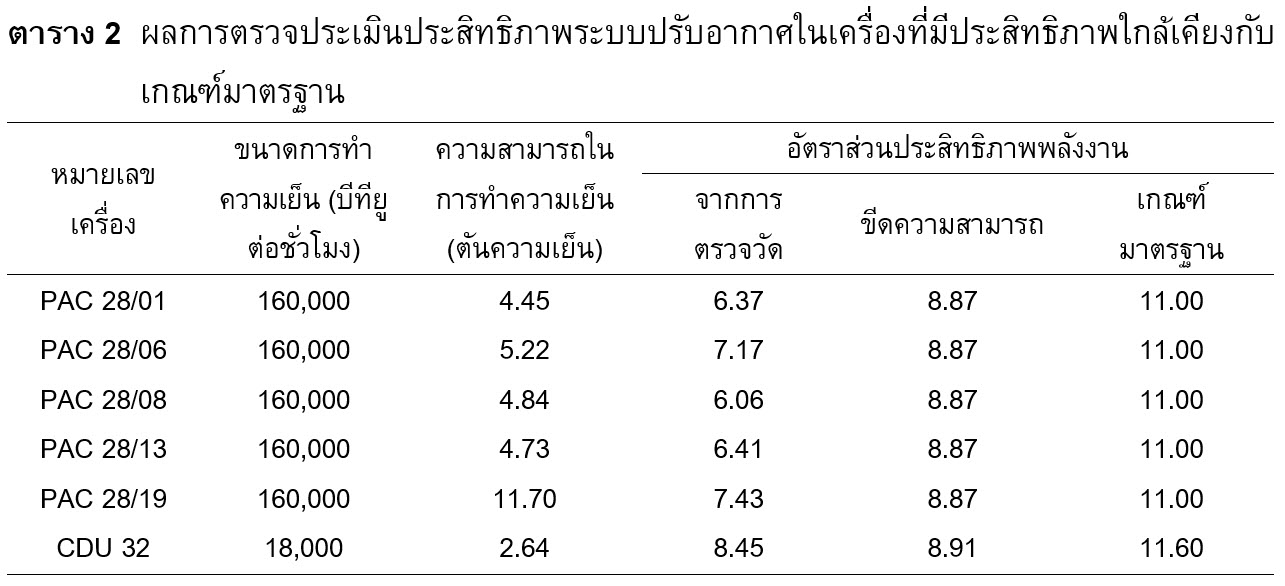การประเมินการอนุรักษ์พลังงานในบริษัทผลิตชิ้นส่วนรถยนต์
Main Article Content
Abstract
Krittaphas Mongkoldhumrongkul, Phatcharapron Sukkanta and Mathin Jaikua
รับบทความ: 15 มีนาคม 2563; แก้ไขบทความ: 18 มิถุนายน 2563; ยอมรับตีพิมพ์: 22 กรกฎาคม 2563
บทคัดย่อ
การจัดทำมาตรการอนุรักษ์พลังงานจำเป็นต้องจัดทำอย่างเหมาะสมต่อการใช้พลังงานในแต่ละระบบ ทั้งนี้ผลลัพธ์อาจมีความแตกต่างกันไปตามการกำหนดมาตรการและวิธีการดำเนินมาตรการ โดยมักประเมินประสิทธิภาพการอนุรักษ์พลังงานจากผลประหยัดและระยะเวลาคืนทุน งานวิจัยนี้ต้องการหามาตรการอนุรักษ์พลังงานของบริษัทผลิตชิ้นส่วนรถยนต์ต้นแบบในระบบไฟฟ้าแสงสว่าง ระบบปรับอากาศ และระบบอัดอากาศ เพื่อเป็นแนวทางในการอนุรักษ์พลังงานรวมทั้งประเมินศักยภาพการลดการปล่อยก๊าซเรือนกระจกจากการเพิ่มประสิทธิภาพการใช้พลังงาน ผลการดำเนินงานพบว่าระบบปรับอากาศเป็นระบบที่มีการใช้พลังงานมากที่สุด การดำเนินมาตรการในระบบนี้จึงมีประสิทธิภาพมากที่สุด นอกจากนี้การดำเนินการตามมาตรการสามารถลดการใช้พลังงานของทุกระบบลงได้ 742,363.00 กิโลวัตต์–ชั่วโมงต่อปี คิดเป็นผลประหยัดประมาณ 2,665,083.10 บาทต่อปี ทั้งนี้ภาพรวมจากการอนุรักษ์พลังงานนี้สามารถลดการปลดปล่อยก๊าซคาร์บอนไดออกไซด์ได้ประมาณ 402.4744 ตันคาร์บอนไดออกไซด์เทียบเท่า งานวิจัยนี้จึงเป็นการช่วยลดภาวะโลกร้อนและนำไปสู่การเป็นสังคมคาร์บอนต่ำเพื่อการพัฒนาที่ยั่งยืน
คำสำคัญ: การจัดการพลังงาน การอนุรักษ์พลังงาน ภาวะโลกร้อน สังคมคาร์บอนต่ำ ชิ้นส่วนรถยนต์
Abstract
The energy conservation measures are needed to be appropriately implemented for individual system. However, the obtained measures may depend on the particular regulation and implementation applying on the system. The energy conservation efficiency is usually evaluated by the outcome of energy–saving and payback periods. This research aimed to discover energy conservation measures of the auto part manufacturing company in the lighting, the air conditioning, and the compressed air system, in order to conduct the measures for energy conservation and to assess the potential to reduce greenhouse gas emission while increasing the efficiency of energy consumption. After the measures was applied, the results revealed that the air conditioning system consumed highest amount of energy, thus the implemented measures exerted the most efficiently on this system. The implementation of the measures could entirely reduce energy use at 742,363.00 kilowatt–hours per year that had the value of 2,665,083.10 baht saving per year. Moreover, these implementations could reduce carbon dioxide emission approximately at 402.4744 tons of carbon dioxide equivalent. This research therefore helps in reducing global warming and leads to a low–carbon society for sustainable development.
Keywords: Energy management, Energy Conservation, Global warming, Low–carbon society, Auto part
Downloads
Article Details

This work is licensed under a Creative Commons Attribution-NonCommercial 4.0 International License.
References
Aongkanon, C. (2018). Energy conservation potentials for manufacturing of basic metal: A case study of steel wire industry. Journal of Energy and Environment Technology 5(1): 52-60. (in Thai)
Chuwong, P., Cheewananthachai, T., and Pisitsangkakarn, S. (2015). Reduction of electrical energy consumption in metal sheet cutting plant. Kasem Bundit Engineering Journal 5(1): 42–52. (in Thai)
Department of Alternative Energy Development and Efficiency, Ministry of Energy [DEDE]. (2007a). Energy Conservation Promotion Act B.E.2535 (1992) and the additional amendment B.E.2550 (2007). Retrieved from https://www.dede.go.th/more_ news.php?cid=59, June 18, 2019. (in Thai)
Department of Alternative Energy Development and Efficiency, Ministry of Energy [DEDE]. (2007b). Energy Saving in Industry. Retrieved from https://www.dede. go.th/ewt_w3c/ewt_news.php?nid=680&filename=, June 16, 2019. (in Thai)
Department of Alternative Energy Development and Efficiency, Ministry of Energy [DEDE]. (2011). Training Manual on Energy Conservation Potential Assessment. Retrieved from http://www2.dede.go.th/bhrd/old/Download/file_handbook/M_T_Building/assen_latency_Handbook.pdf, June 16, 2019. (in Thai)
Department of Alternative Energy Development and Efficiency, Ministry of Energy [DEDE]. (2017). Manual of Person Responsible for Energy in Designed Factory. Retrieved from http://www2.dede.go.th/bhrd/old/file_handbook.html, September 9, 2019. (in Thai)
Department of Alternative Energy Development and Efficiency, Ministry of Energy [DEDE]. (2018). Energy Situation of Thai-land 2018. Retrieved from https://www.dede.go.th/ewt_news.php?nid=47349, June 16, 2019. (in Thai)
Electricity Generating Authority of Thailand [EGAT]. (2018). Standard of Air Condi-tioner Efficiency. Retrieved from http://labelno5.egat.co.th/new58/wp-content/uploads/2017/form/mn/air.pdf, August 14, 2019. (in Thai)
Internet. (2019). Energy Conservation in Industry. Retrieved from http://www.tech nologymedia.co.th/articledetail.asp?arid=3008&pid=299, June 16, 2019. (in Thai)
Jantasit, K., Intarawong, O., and Chaiphong, S. (2013). Electrical energy management in Faculty of Industrial Technology Sciences. Rajabhat Rambhai Barni Research Journal 7(2): 116–122. (in Thai)
Kruewal, S. (2005). Energy Conservation by Management Technique (Value Engineering): Case Study of a Food and a Textile Factories. Master of Engineering. Bangkok: King Mongkut’s University of Technology Thonburi. (in Thai)
Limchupornwikul, B. (1987). Energy Electrical Conservation in Soup Industry. Master of Science. Bangkok: King Mongkut’s Institute of Technology Thonburi. (in Thai)
Nimnuan, W., Rakkarn, S. Prapon Sihomchai, P., and Jindawattana, A. (2012). Management of potential energy conservation measures in small and medium industrial. Kasem Bundit Engineering Journal 2(2): 77–95. (in Thai)
Phachoensukchanachok, A. (2007). Reduction of Electrical Power Consumption in a Sandal Factory: A Case Study of JAS Foot Wear LTD. Master of Engineering. Bangkok: King Mongkut’s Institute of Technology North Bangkok. (in Thai)
Phomprasit, S. (2016). The electricity cost re-duction in industry: A case study on Thammarat Concrete Company Limited. Naresuan University Engineering Journal 11(2): 9–19. (in Thai)
Pinainetisart, P. (2012). Management of Office Building for Energy Conversation: A Case Study of Dr. Jaroen Kantawong Building. Master of Art. Bangkok: Bangkok University. (in Thai)
Royal Thai Government Gazette [RTGG]. (2018). Announcement of the Department of Labour Protection and Wel-fare: Illumination Standard. Retrieved from http://www.mratchakitcha.soc.go.th/ announce.html, October 29, 2019. (in Thai)
Sriphadet, C. (1990). Energy Conservation in a Paper Mill Factory. Master of Science. Bangkok: King Mongkut’s Institute of Technology Thonburi. (in Thai)
Thailand Greenhouse Gas Management Organization (Public Organization) (TGO). (2017). Thailand Grid Emission Factor for GHG Reduction Project/ Activity. Retrieved from http://ghgreduction.tgo.or.th/24-t-ver/t-ver/t-ver-news-and-activities/292-thailand-grid-emission-factor-for-ghg-reduction-pro ject-activity.html, November 27, 2019. (in Thai)
Thailand Greenhouse Gas Management Organization (Public Organization) (TGO). (2019). Quantified Co–benefits of Climate Change Mitigation. Retrieved from http://www.tgo.or.th/2015/thai/news_detail.php?id=1087, December 15, 2019. (in Thai)
Wiwattanacheewin, K., Rakkarn, S., Klungkuarmdee, A., and Sakulthai, T. (2017). Lighting energy management for cosmetics manufacturing. Kasem Bundit Engineering Journal 7(2): 14–28. (in Thai)
